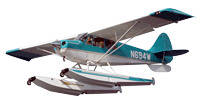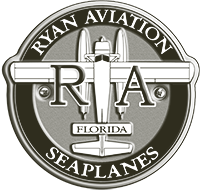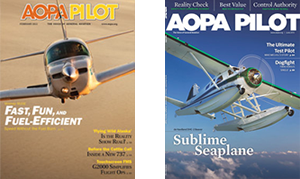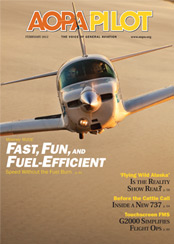
Water Dog
AOPA Pilot Magazine
This article showcasing our Amphibious Aviat Husky seaplane was published in the February 2012 issue of AOPA Pilot Magazine, Volume 55, Number 2. Our thanks to the AOPA and author Dave Hirschman as well as photographer Mike Hizer.
Taking a Husky to the Lake
The small attach points on the side of the AOPA 2012 Sweepstakes Tougher Than a Tornado Husky are easy to overlook and have no real bearing on the way the airplane flies day to day.
But those fittings are part of a floatplane kit that gives the Tornado Husky the potential to open up a whole new world of water flying for its winner.
The factory fittings simplify the installation of straight or amphibious floats for flying on and off the water. And the Tornado Husky, with its excellent power-to-weight ratio; hard-pulling, constant-speed prop; long endurance; and stable, low-speed handling has all the attributes of a world-class seaplane.

CFI Dan Nichols (left) demonstrates some of the emergency equipment in the seaplane to the author.
To find out more about the Husky’s water capabilities — and what it takes for a land pilot to gain a seaplane rating — I traveled to Flagler County Airport (XFL) on Florida’s Palm Coast, home of Ryan Aviation. The company is owned by Tripp Wacker, a veteran floatplane instructor and FAA-designated pilot examiner who bailed out of an airline flying job because he "wanted to come to work every day wearing shorts and flip-flops." He owns a Husky A–1B on Wipline amphibious floats and offers intensive two- and three-day courses that take pilots of varying experience levels to private, commercial, or ATP seaplane ratings.
Dan Nichols, a CFI and IA with more than 1,000 hours of dual instruction given in the Ryan Aviation Husky, led me through the flight and ground training during two strenuous, educational, and thoroughly enjoyable days that showed some of the possibilities available to floatplane fliers.
"There are things you can do, places you can go, and experiences you can have flying floatplanes that are simply unavailable in any other form of flying," said Wacker, who has been instructing in seaplanes at Flagler County since 1989. "I’ve traveled to remote lakes in Canada that were so far off the beaten path that floatplanes were the only practical way to get there. The adventures you can have in these airplanes are difficult to imagine for pilots who are limited to hard-surface runways."

Big and tall
A Husky on amphibious floats is 10 feet, 6 inches tall, and towers over wheeled versions — even the Tornado Husky with its oversized tundra tires. And the fact that the amphib has four wheels like a shopping cart just looks wrong to land pilots accustomed to seeing three.
The most important part of the amphib preflight inspection is purging water from the eight compartments on each float using a hand pump. The process eliminates unnecessary weight and dries out the inside of the metal floats, which also are plumbed with hydraulic and electrical lines. Then there’s a whole series of additional cables and pulleys to inspect, as well as retractable water rudders (linked to the regular rudder) that steer the airplane on the water.
The float-equipped Husky is still a responsive, well-balanced airplane.
Other essentials for floatplane flying — such as an oar, anchor, and inflatable life vests—are mostly foreign to land pilots.
The amphibious floats add 325 pounds to the empty weight of the airplane and reduce the Husky’s payload. With two adults (400 pounds total) and about 15 pounds of gear, we’re limited to 18 gallons of fuel to keep the Husky below its maximum gross weight.
Once inside the cockpit, the instrument panel itself is little changed except for a gear advisory system that shows four green lights for land operations, four blue lights for water takeoffs and landings, and a red light that lets the pilot know when the electromechanical landing gear motor (housed in the airplane’s aft battery compartment) is turning. The system contains an aural warning system (female voice for water landing, and a male voice for land) and mechanical indicators.
The lights, aural, and mechanical gear position indicators on the floats themselves may seem like overkill, but it’s absolutely imperative for the landing gear on an amphibious floatplane to be in the proper position during every takeoff and landing. A gear-up landing in a land airplane is regrettable but seldom fatal—but an amphibian’s gear-down landing in the water can be disastrous.
The start-up and taxi procedures are virtually identical to any wheeled Husky. The only significant difference is that on land the pilot must ensure that the landing gear handle is in the down position before turning on the master electrical switch. (There are no squat switches in the amphibious floats, so putting the handle in the Up position would raise the gear right away.)
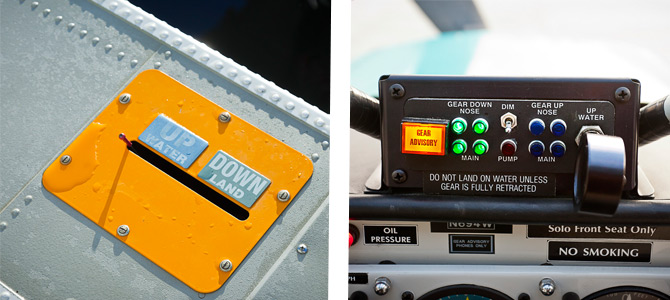
Mechanical indicators on the floats (left) and a lighted advisory system on the panel (right) show gear positioning, a critical factor for amphibious airplanes.
Ground handling in the amphib Husky is far simpler than in the tailwheel variety. The airplane is level, so the nose doesn’t block the forward view, and visibility in all directions from the commanding height is great. The nose wheels free caster, but steering is smooth and positive using differential braking.
With full flaps (30 degrees) and the Husky at its maximum gross weight of 2,200 pounds, acceleration is steady and the airplane gets to its 55-mile-per-hour rotation speed in just under 1,000 feet (80 degrees Fahrenheit, 10-knot quartering headwind, 35-foot elevation). Once a positive rate of climb is established, it’s time to start raising the manual flaps, then the landing gear.

Pumping water out of the floats is an essential part of each pre- and postflight inspection.
An 80-mph climb results in a 900-fpm rate of climb to pattern altitude, and we continue climbing westbound to 1,600 feet. The floatplane indicates 100 mph in cruise (23 inches of manifold pressure and 2,300 rpm), and it’s much more stable in roll than wheel-equipped versions. The floats and ventral fin require more rudder to lead turns, and the roll rate is noticeably reduced, but not dramatically so. The float-equipped Husky is still a responsive, well-balanced airplane.
Stalls break straight ahead with the flaps up or down, and the wing (without vortex generators) gives plenty of aerodynamic stall warning.
Ryan Aviation uses two lakes for the vast majority of its flight training. Gore Lake lies on airport property, and it looks small enough from the air to be a golf course water hazard. It’s actually 3,000 feet long and is located just short of the approach end to Runway 6. Air traffic controllers in the Flagler tower allow the Husky to operate below the usual traffic pattern for land-based airplanes. Crescent Lake, an expansive piece of water with a tree-lined island and miles of marshy, undeveloped waterfront, is about 12 miles west of the airport.
Nichols demonstrated the first landing at Gore Lake, and the experience of touching down lightly on the water, slowing, then settling in was delightful. On a warm, dry Florida afternoon at a lake inhabited by ducks, egrets, and at least one osprey, the scene was completely entrancing. Once the Husky finished its transition from air to water mode, Nichols introduced idle, plow, and step taxiing; docking; and a "confined-area takeoff," a circular, high-speed taxi that becomes a takeoff when the airplane encounters its own wake.
"We’re faster than just about any speed boat on the water," Nichols said. "The Husky is such a fantastic floatplane, the biggest danger to pilots is overconfidence."

My turn
Sitting in the water at one end of the tree-lined lake, I can say with authority that I’m not overconfident. In fact, the towering pines on the opposite shore seem terribly close. But even on a warm afternoon, our calculations tell us the airplane will need just 1,750 feet to clear 50-foot obstacles. The airplane accelerates quickly, leaps out of the water, and easily vaults over the trees.
The next morning we fly to Crescent Lake for glassy water takeoffs and landings. Glassy water landings, in which pilots must land with little or no depth perception, are the most hazardous for floatplanes, and realistic conditions make the practice especially challenging. Heading southeast toward the shimmering glare of the rising sun, we set up a constant airspeed (65 mph) and shallow descent rate (150 fpm), and hold it all the way to touchdown. Glassy water takeoffs require lifting the right float off the water before the left to reduce surface friction and get the airplane airborne as quickly as possible. Once the airplane is "on the step" at 45 mph, the ailerons have enough authority to raise the right float. With the drag reduced, the airplane quickly accelerates to 55 mph and is ready to fly.
We also practice simulated engine-out landings that require steep descents to preserve enough speed to flare just above the water ("You want the lake to fill your windscreen during the descent," Nichols said. "Anything else is too shallow.")
Each scenario is novel and fast-paced, and flying over the big lake and its natural areas hints at the possibilities for future floatplane adventures. As we pass a few feet over a vacant shoreline, schools of fish jump out of the water. An osprey hunts nearby, a late-season flock of geese makes its way south, and several bald eagle nests fill the tops of leafless trees.
"You’d never know any of these things even exist when you go over in the flight levels," Wacker said. "This kind of flying puts you right there in it."
What it costs
A private or commercial seaplane rating costs $1,500 at Ryan Aviation if everything goes perfectly. That covers four hours of dual instruction in the amphibious Husky, ground training, and a one-hour checkride.
Ryan also offers a more involved ATP seaplane course as well as dual instruction in an amphibious de Havilland Beaver. Flight time in the amphibians is logged as complex aircraft experience, and Wacker encourages commercial students to combine the complex airplane experience required for the commercial certificate and seaplane training and get both ratings at the same time.
Adding floats to a Husky can range widely in cost. A new set of straight floats offers the advantages of being lighter, mechanically simpler, and far less expensive than amphibious floats. Straight Wipline floats for a Husky carry a retail cost of $30,000 new, and installation is an additional $5,000. A new set of amphibious Wipline floats costs about $47,000, and the installation is more complex and costs $8,600. It can take about two weeks to install amphibious floats on a Husky for the first time, but subsequent changes between floats and wheels can be done much more quickly. P.K. also makes amphibious floats for Huskys with a higher retail price of $49,000 but lower installation costs of $3,000.
"Amphibious floats make it possible to fly seaplanes without the logistical hassles," Wacker said. "You can put in anywhere, so pilots who don’t have the luxury of lakefront property and a dock can still get their feet wet."
The checkride
Wacker administers the ground portion of the seaplane examination with a disarmingly casual style, but he’s always probing for weakness. If a student knows weather and wind patterns, he’ll quickly move on to water regulations and buoy markings, subjects the U.S. Coast Guard veteran and former commercial fisherman knows cold.
Once in the airplane, he banters with air traffic controllers at the busy airport where Embry-Riddle Aeronautical University flight students fill the traffic pattern. The controllers limit the Husky to 500-foot-agl traffic patterns at the nearby lake—an ideal altitude for floatplane pilots to see objects on the water, as well as winds and obstructions.
We take off from Runway 11, turn downwind, and are quickly cleared for the first of multiple approaches to the lake. The flight portion of the exam includes normal, rough water, and glassy water takeoffs and landings as well as a simulated power-off approach and landing, various forms of taxiing, docking, and practice go-arounds. I feel well prepared by the previous training flights, yet still manage to insert a few boneheaded blunders. (Note to self: Make sure the carb heat is cold before starting a takeoff!)
But the best part is the water flying demo that follows.
AOPA Senior Photographer Mike Fizer is on the lakeshore with cameras and a radio, and Wacker puts on a precision floatplane demonstration that shows real mastery. "How about I touch down on one float at the edge of the lake pointing right at the camera?" he asks, then performs the maneuver flawlessly. It’s the flying equivalent to a pool hustler calling and then sinking a series of difficult shots. For 45 minutes, Wacker runs the table.

When it’s over, Wacker emphasizes that, perhaps even more than other pilot certificates, a seaplane rating is a license to learn. And few pursuits could be as sublime as exploring the finer points of floatplane flying, an endeavor that combines the best of the nautical and aeronautical.
Email the author at dave.hirschman@aopa.org.
